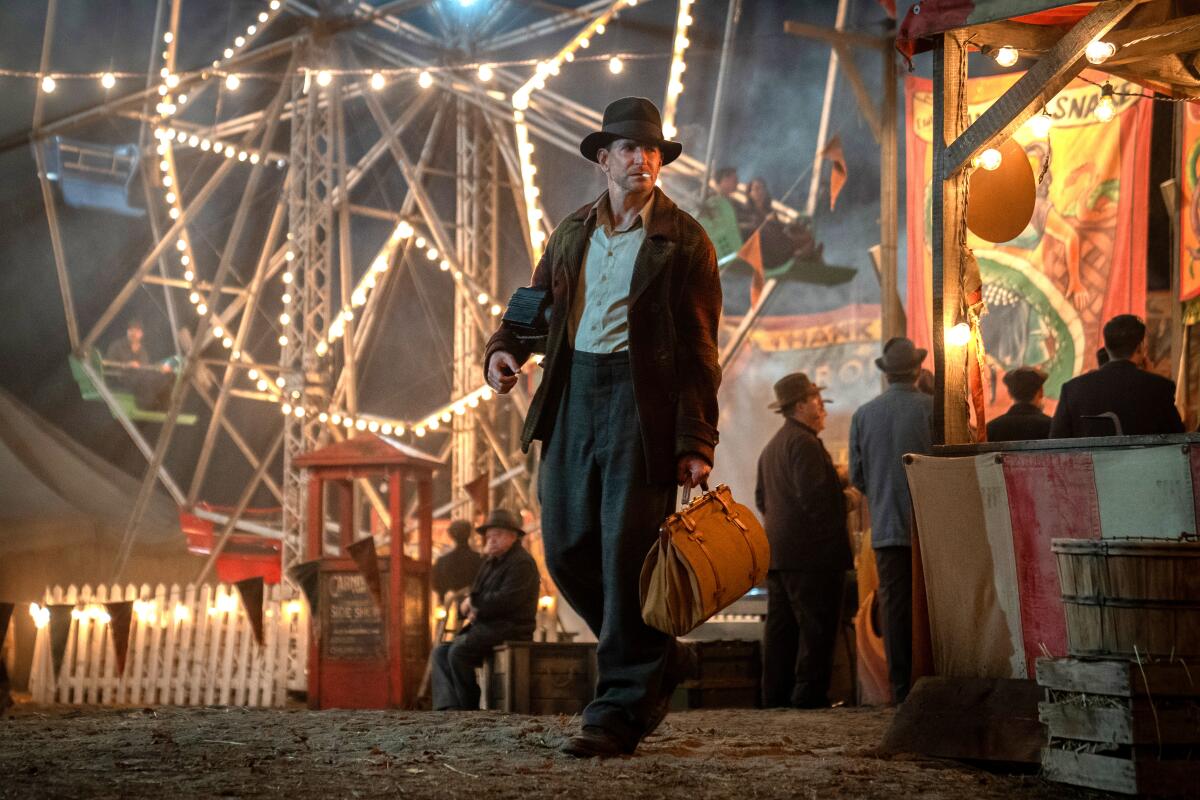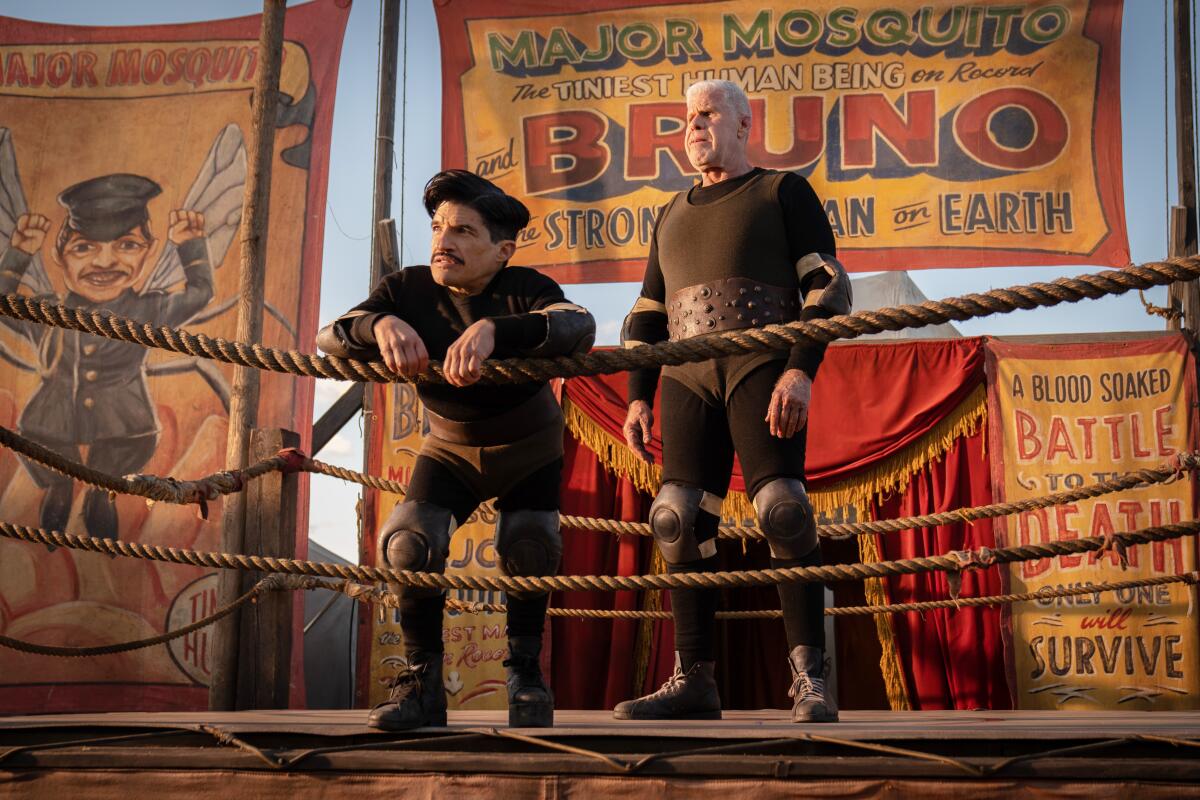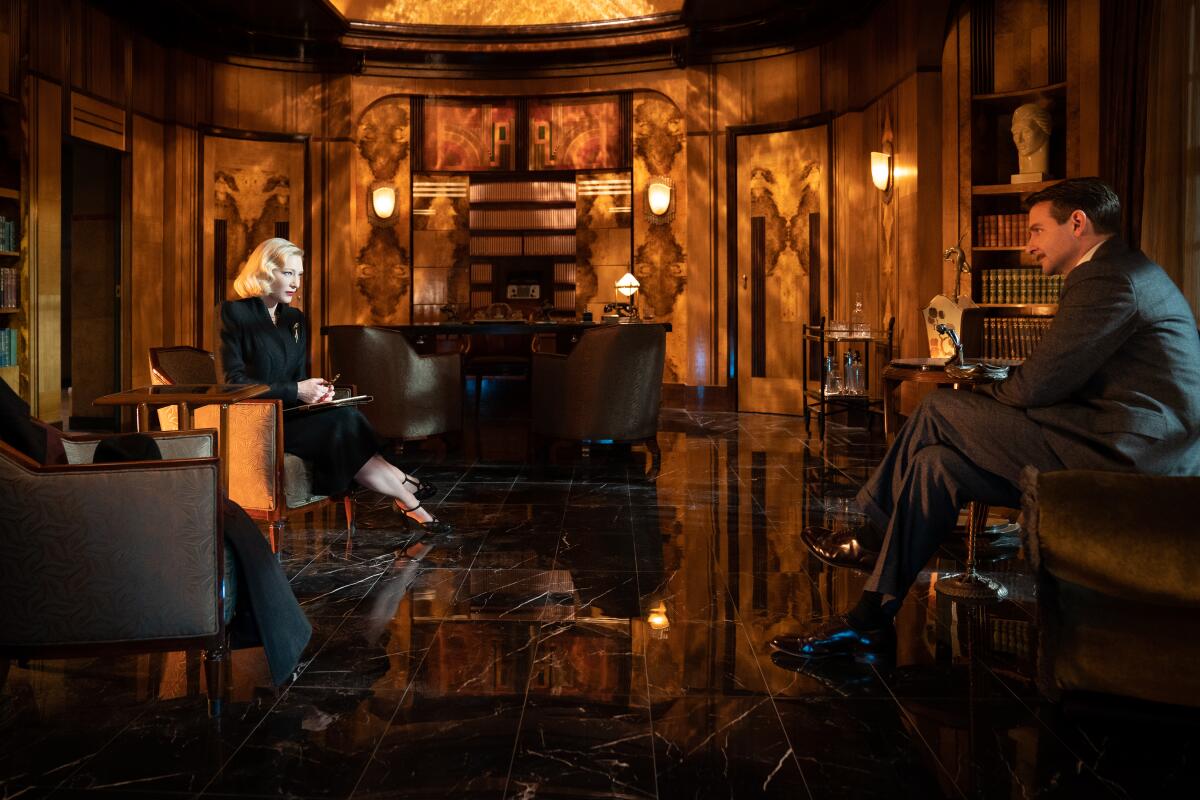Guillermo del Toro dives into three key ‘Nightmare Alley’ scenes

- Share via
Things rarely happen by accident in a Guillermo del Toro movie. The Oscar-winning director of 2018’s best picture, “The Shape of Water,” has now crafted “Nightmare Alley,” a noir thriller about a grifter (Bradley Cooper) who falls in with a group of carnies, steals their tricks and becomes a successful “mentalist,” only to meet his larcenous match and wind up in rags. Yet the antihero’s ugly behavior assumes a certain beauty through the film’s exacting design.
Speaking from his office in Los Angeles, Del Toro, who co-wrote “Nightmare Alley” with his new wife, Kim Morgan, says, “In my mind, the work of a director is to keep all the departments — production design, cinematography, wardrobe, makeup and hair — telling the story. You want to coordinate all these elements to create a balance between majesty and brutality in service to an atmosphere that plays as this almost nightmarish Jungian noir.”
Here, Del Toro tells The Envelope how he precision-tuned three pivotal “Nightmare Alley” scenes.
Introducing the Carnival
Built in three different incarnations on the grounds of Markham Fairgrounds outside Toronto by production designer Tamara Deverell and her team, the 1939-era carnival entices Cooper’s Stanton character with glittering lights and seedy sideshows. “One of the hardest things to do with a carnival is to not fall for the whimsy,” Del Toro says. “In our film, everything from the popcorn bags, to the toys in the stalls, the plaster prizes, the wooden rings, the fastening for the tarps, which were handmade from leather and brass — all of that was accurately reproduced from photographs and artifacts of the era. That realness gives a richness to the image that keeps an audience interested.”

Stanton succumbs to the carnival’s lurid charms one night shortly after waking up in a bus. “The sequence starts as a single shot,” Del Toro says. “The sun’s in the distance, the camera stays on Stanton, the light changes to night, and we see the Ferris wheel reflected in the bus window when he wakes up to this new reality. He gets off the bus and follows this little person Major Mosquito into the carnival. I wanted to create this dark fairy-tale feel. Stanton doesn’t talk at all for the first 20 minutes, so in place of dialogue, it’s important for the camera to show what he’s looking at, with Bradley in the frame. He’s an interesting figure to follow, just from the way Bradley wears his character’s body language.”
Where Stanton goes, the audience follows. “This incarnation of the carnival was designed precisely for the shot so that we can go from the confinement of the bus to this wide-angle lens sprawling shot of the carnival and from the height of the Ferris wheel, then mount the camera on a techno crane and undersling it, meaning the camera’s almost scraping the ground. Little by little, we get into the depths of the carnival when Bradley enters the geek show. Then our crane goes up to show us this circular arena. From that moment on, circles follow Stanton to the very end. For me, the movie is a circle, playing like a loop, like a dream, like a nightmare.”
Cate Blanchett’s Art Deco Lair
Flash forward two years and Stanton’s now a tuxedo-clad mentalist, impressing big-city psychiatrist Lilith (Cate Blanchett) in a nightclub when he guesses the contents of her purse. Seeing a potential partner in crime, Stanton visits Lilith in her opulent Art Deco headquarters. “We do a camera move in this scene that I do in every one of my movies,” Del Toro says. “I call it the ‘hinge.’ You start with a side shot, and then I turn the camera and unveil the set. Here, Stanton enters a tiny room where he parts two sliding doors like a curtain. They open to a grand theatrical set that perfectly defines the character of Lilith. It’s exquisite and aloof and tightly organized, but everything in her office is hidden behind secret doors that conceal the recorder, the safe, a secret entrance, hidden microphones. Like Lilith, it’s all beneath the surface.”
The elegant office hosts a battle of wits between Stanton and Lilith. “The scene is like both a chess game and a courtship between two alpha predators,” Del Toro notes. “Bradley and Cate had such strong chemistry, I filmed as much as I could with single shots using a techno crane with a remote control. We made the staging about heights: When Stanton’s down, she’s up. She sits on her divan, he’s standing.”

Under Pressure: The Lie Detector Scene
Armed with confidential information, Stanton meets Lilith’s patient Ezra Grindle at his enormous estate, posing as a spiritualist who can contact the fearsome millionaire’s dead lover — for a price. “The idea is that we’re introducing the power of this guy through the building, the corridors, the bodyguards. And again, I do the hinge, when we introduce Ezra sitting simply in a little chair in the middle of this huge space. The building is actually the R.C. Harris Water Treatment Plant in Toronto. I love setting the scene in this gigantic alley of industrialist splendor.”
Grindle demands that Stanton take a lie detector test. Del Toro underscores the tension when the tester asks if he can really communicate with ghosts. “We set up the camera on a mini-gib and push in on Bradley’s face. I’m thinking of Dana Andrews, the master of bottled emotion, on the phone sweating in [Otto Preminger’s 1950 noir] ‘Where the Sidewalk Ends.’ Stanton closes his eyes and does the one thing he’s never supposed to do, which is to believe his own lies. He professes to being in contact with the dead. For that shot, we positioned this architectural ornament exactly behind Stanton as if rays of light are coming out of his head like he’s a saint. We rarely go in close on Bradley, but when we do, it counts.”
More to Read
From the Oscars to the Emmys.
Get the Envelope newsletter for exclusive awards season coverage, behind-the-scenes stories from the Envelope podcast and columnist Glenn Whipp’s must-read analysis.
You may occasionally receive promotional content from the Los Angeles Times.










